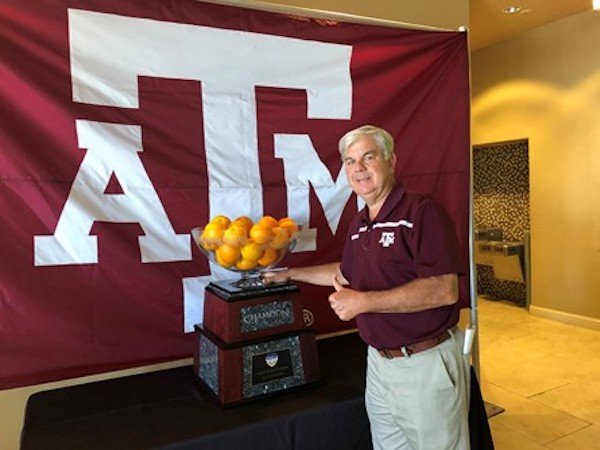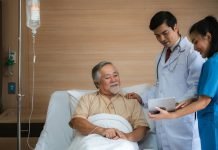
After temporarily losing function on his left side, Gary Pearson is passionate about raising awareness of stroke symptoms and how stroke can be prevented.
“It was a shock because I had never been sick a day in my life before then,” the 65-year-old from Houston said.
But with the help of his doctors from The University of Texas Health Science Center at Houston (UTHealth), he is back to living his very active life.
A stroke is when the blood supply to part of the brain is interrupted or reduced, which prevents the brain from getting the oxygen and nutirents it needs.
It is the fifth leading cause of death in the U.S. according to the Centers for Disease Control and Prevention and the leading cause of serious long-term disability.
The outcome a patient has following a stroke is dependent on where in the brain the stroke occurred.
“It’s all about real estate when it comes to stroke,” said Sean I. Savitz, director of the UTHealth Institute for Stroke and Cerebrovascular Disease.
“Gary’s stroke occurred so that it affected the left side of his body, making it difficult for him to use his left arm and left leg.
However, if the stroke had occurred just a few millimeters from where it did, it would have made a huge difference and his paralysis would have been much worse.”
In April 2020, Pearson was at a luncheon in Sugar Land when he noticed that his lips, left leg, and left arm started not working correctly.
“There was a doctor friend of mine sitting at the next table that said,” You look like you are having a stroke,'” Pearson said. “I got up and walked across the street to the closest emergency room, where they told me that is exactly what was happening.”
After that initial visit to the emergency room, Pearson’s sister, who works for UTHealth, arrange for him to be transferred to Savitz’s care at Memorial Hermann – Texas Medical Center.
Pearson spent a few days in the hospital before transferring to inpatient rehab to regain his strength, mobility, and balance.
“I told Dr. Savitz I was going to walk out of the hospital on my own and three weeks later, I did,” he said.
Pearson credits his health before the stroke, and the dedication of Savitz, for why he is so healthy now.
“He has made an incredible recovery and I think a large part of that is his dedication to physical activity and his desire to remain independent,” Savitz said.
“He has worked hard to control his blood pressure, become more active, and changed his diet. These small steps will go a long way toward making sure he remains healthy, and dramatically reduces his risk of having another stroke in the future.”
Pearson is now back to doing all of the things he enjoys. “I play 18 to 36 holes of golf every weekend and I love it,” he said.
Savitz also explained that having preexisting conditions such as diabetes, high cholesterol, and a history of blood clots can also put someone at higher risk of a stroke.
And, according to the American Stroke Association, 1 in 4 Americans who have had one stroke will have another in their lifetime.
Pearson is passionate about getting the information about risk factors, warning signs, and symptoms of a stroke more widely known so that people are aware of what could happen.
“Do anything you can to lessen your risk: exercise, eat right, and visit the doctor as soon as possible if something feels off,” Pearson said.
Pearson now follows up with Savitz two to three times a year to make sure he remains healthy and continues to follow an exercise regimen that includes walking three miles a day on a treadmill, swimming, running, and playing baseball.
While Savitz continues to monitor Pearson’s recovery he also hopes to be able to pinpoint how Pearson has been able to recover so fully.
“People like him as so remarkable in how they bounce back and get stronger after an event like a stroke. We are hopeful we can learn something from how Gary has recovered that we can use to help other people in the future,” he said.
Savitz said upcoming research at UTHealth will look at how risk factors for stroke differ depending on an individual’s genetic makeup.
“You won’t find more expertise anywhere in the U.S. than here,” Savitz said. UTHealth is a global leader in stroke research and in the care of stroke patients.
The stroke institute established by McGovern Medical School’s Department of Neurology and Memorial Hermann – TMC was the first in Houston.
As Pearson looks forward to continuing his active life, he wants to never lose sight of how lucky he was.
“I volunteer as an usher at my church and a few weeks ago, I got to help someone else who had had a stroke up to the alter to receive communion.
One of the other ushers asked me why it was so important for me to help him and I said, ‘That could just have easily been me needing help. I’m one of the lucky ones.”
If you care about stroke, please read studies about these 7 things can tell your future heart disease, stroke risk and findings of wearing a blood pressure cuff may help prevent stroke.
For more information about stroke prevention and treatment, please see recent studies about your weight history could predict your risk of heart disease and stroke and results showing that 4 things may increase your stroke and heart attack risks.




